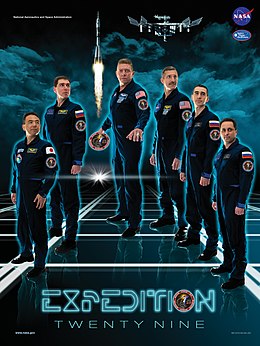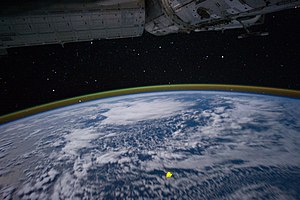
Satoshi Furukawa is a Japanese surgeon and JAXA astronaut. Furukawa was assigned to the International Space Station as a flight engineer on long-duration missions Expedition 28/29 (2011) and Expedition 69/70 (2023-2024).

Akihiko Hoshide is a Japanese engineer, JAXA astronaut, and former commander of the International Space Station. On August 30, 2012, Hoshide became the third Japanese astronaut to walk in space.

Sergey Nikolayevich Ryzhikov, lieutenant colonel of Russian Air Force, is a Russian cosmonaut, selected in 2006. He is a veteran of two long duration space flights to the ISS.

Sergey Aleksandrovich Volkov is a retired Russian cosmonaut and engineer. He was a member of three missions to the International Space Station, spending more than a year in total in space. During his missions he did four spacewalks lasting more than 23 hours in total. Volkov retired from the Cosmonaut group in February 2017.
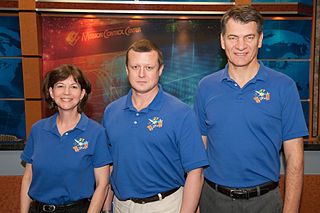
Soyuz TMA-20 was a human spaceflight to the International Space Station (ISS) and was part of the Soyuz programme. It lifted off from the Baikonur Cosmodrome in Kazakhstan on December 15, 2010, and docked with the ISS two days later. The three-person crew of Soyuz TMA-20 – Dmitri Kondratyev, Catherine Coleman and Paolo Nespoli – represented the ISS partner organizations of Roscosmos, NASA and the European Space Agency (ESA). Soyuz TMA-20's crew represented half of the members of Expedition 27; the other three members of the expedition arrived at the station on board Soyuz TMA-21 on April 6, 2011. The COSPAR ID of Soyuz TMA-20 was 2010-067A. It is ISS flight 25S.

Anton Nikolaevich Shkaplerov is a former Russian cosmonaut. He is a veteran of four spaceflights.

Andrey Ivanovich Borisenko is a Russian cosmonaut. He was selected as a cosmonaut in May 2003, and is a veteran of two long duration missions to the International Space Station.

Expedition 26 was the 26th long-duration mission to the International Space Station. The expedition's first three crew members – one US astronaut and two Russian cosmonauts – arrived at the station on board Soyuz TMA-01M on 10 October 2010. Expedition 26 officially began the following month on 26 November, when half of the crew of the previous mission, Expedition 25, returned to Earth on board Soyuz TMA-19. The rest of the Expedition 26 crew – one US astronaut, one Russian cosmonaut and one ESA astronaut – joined the trio already on board when their spacecraft, Soyuz TMA-20, docked with the station on 17 December 2010.

Soyuz TMA-21 ("Gagarin") was a Soyuz flight to the International Space Station (ISS). It transported three members of the Expedition 27 crew to the ISS, and docked at the station on April 6, 2011. TMA-21 is the 109th flight of a Soyuz spacecraft, the first of which launched in 1967. The Soyuz remained attached to the space station as a lifeboat, throughout the remainder of Expedition 27 and through the end of Expedition 28, and returned to Earth on September 16, 2011.

Kimiya Yui is a Japanese astronaut from the Japan Aerospace Exploration Agency (JAXA). He was selected for the agency in 2009.

Expedition 28 was the 28th long-duration expedition to the International Space Station, and began on 23 May 2011 with the departure of the members of Expedition 27. The first three members of Expedition 28 arrived on the ISS aboard the Soyuz TMA-21 spacecraft on 4 April 2011, and were joined on 9 June 2011 by the three other crew members, who arrived aboard Soyuz TMA-02M. The expedition saw a number of significant events, including the final Space Shuttle mission, STS-135, which took place in July 2011. Expedition 28 was superseded by Expedition 29 on 16 September 2011.

Soyuz TMA-02M was a space mission that transported three members of the Expedition 28 crew to the International Space Station. TMA-02M was the 110th flight of a Soyuz spacecraft and the second flight of the improved Soyuz-TMA-M series. The Soyuz remained docked to the space station for the Expedition 28 increment to serve as a potential emergency escape vehicle.

Soyuz TMA-22 was a crewed spaceflight to the International Space Station (ISS). TMA-22 was the 111th flight of a Soyuz spacecraft, and transported three members of the Expedition 29 crew to the ISS. The spacecraft docked to the ISS on 16 November 2011, and remained docked to serve as an emergency escape vehicle until its undocking on 27 April 2012. Soyuz TMA-22 successfully landed in Kazakhstan on 27 April 2012 11:45 GMT.

Soyuz TMA-03M was a spaceflight to the International Space Station (ISS). It launched on 21 December 2011 from Site One at the Baikonur Cosmodrome, Kazakhstan, carrying three members of Expedition 30 to the ISS. TMA-03M was the 112th flight of a Russian Soyuz spacecraft, since the first in 1967, and the third flight of the modernised Soyuz-TMA-M version. The docking with the International Space Station took place at 19:19 Moscow Time on 23 December, three minutes ahead of schedule.
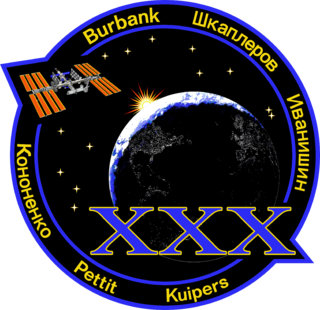
Expedition 30 was the 30th long-duration mission to the International Space Station (ISS). The expedition's first three crew members – Dan Burbank, Anton Shkaplerov and Anatoli Ivanishin – arrived on the ISS aboard Soyuz TMA-22 on 16 November 2011, during the last phase of Expedition 29. Expedition 30 formally began on 21 November 2011, with the departure from the ISS of the Soyuz TMA-02M spacecraft. The expedition ended on 27 April 2012, as Burbank, Shkaplerov and Ivanishin departed from the ISS aboard Soyuz TMA-22, marking the beginning of Expedition 31.

Soyuz TMA-05M was the 114th flight of a Soyuz spacecraft. It was launched on 15 July 2012, transporting three members of the Expedition 32 crew to the International Space Station (ISS). The Soyuz remained docked to the ISS throughout the mission to serve as an emergency escape vehicle. The launch also coincided with the 37th anniversary of the Apollo–Soyuz Test Project. Soyuz TMA-05M successfully returned to Earth on 19 November 2012.
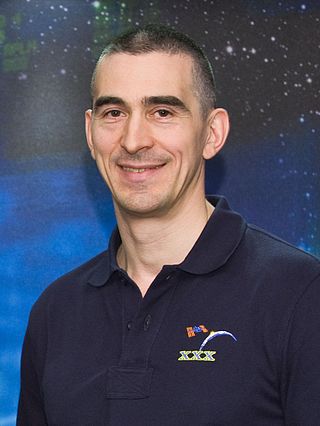
Anatoli Alekseyevich Ivanishin is a former Russian cosmonaut. His first visit to space was to the International Space Station on board the Soyuz TMA-22 spacecraft as an Expedition 29/Expedition 30 crew member, launching in November 2011 and returning in April 2012. Ivanishin was the commander of the International Space Station for Expedition 49.

Soyuz TMA-09M was a Russian Soyuz mission to the International Space Station. It transported three members of the Expedition 36 crew to the space station. The Soyuz remained docked to the space station during Expeditions 36 and 37 to serve as an emergency escape vehicle. The spacecraft landed on 11 November 2013, carrying the same three cosmonauts who were aboard for launch. The crew of Soyuz TMA-09M consisted of Fyodor Yurchikhin of Roscosmos, Karen Nyberg of NASA and Luca Parmitano of the European Space Agency.

Soyuz TMA-15M was a 2014 flight to the International Space Station. It transported three members of the Expedition 42 crew to the International Space Station. TMA-15M was the 124th flight of a Soyuz spacecraft, the first flight launching in 1967. The Soyuz remained docked to the space station for the Expedition 43 increment, serving as an emergency escape vehicle until departing and returning to Earth as scheduled in June 2015.
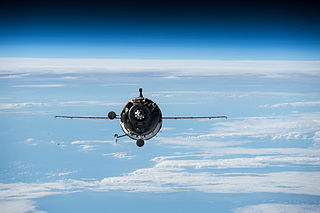
Soyuz TMA-16M was a 2015 flight to the International Space Station. It transported three members of the Expedition 43 crew to the station. TMA-16M was the 125th flight of a Soyuz spacecraft, the first having launched in 1967.
